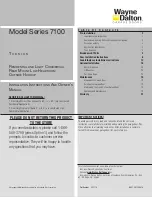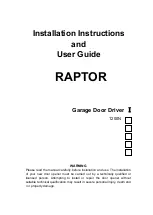
5
IMPORTANT SAFETY INSTRUCTIONS
ENTRAPMENT ALARM (UL 325; 30A.1.1A)
The Mighty Mule® E-Z Gate Opener is designed to stop and reverse within 2 seconds when the gate comes in
contact with an obstruction. Additionally, these openers are equipped with an
audio entrapment alarm
which will
activate if the unit obstructs
twice
while opening or closing. This alarm will sound for a period of 5 minutes, or until
the opener receives an intended signal from a hardwired entry/exit source (e.g. push button control or keypad) and
the gate returns to a fully open or fully closed position. Turning the power switch on the control box OFF and back
ON will also deactivate the alarm. Wireless controls such as transmitters and wireless keypads will not deactivate the
alarm.
Secondary Means of Protection Against
Entrapment
As specified by Gate Opener Safety Standard, UL 325 (30A.1.1), automatic gate openers shall have an inherent entrapment
sensing system, and shall have
provisions for
,
or be supplied with
, at least one independent secondary means to protect
against entrapment. The Mighty Mule® utilizes
Type A
, an inherent
(i.e., built-in) entrapment sensing system as the
primary
type of entrapment protection. Also, the Mighty Mule® has
provisions for
the connection of
Type
B2
protection to be used
as the
secondary
type of entrapment protection, if desired.
1. For gate openers utilizing a contact sensor (e.g., safety edge sensor– Type B2) in accordance with UL 325 (51.8.4 [i]):
A. One or more contact sensors shall be located at the leading edge, bottom edge, and post edge, both inside and
outside of a vehicular swing gate system.
B. A hard wired contact sensor shall be located and its wiring arranged so that the communication between the
sensor and the gate opener is not subjected to mechanical damage.
C. A wireless contact sensor such as one that transmits radio frequency (RF) signals to the gate opener for
entrapment protection functions shall be located where the transmission of the signals are not obstructed or
impeded by building structures, natural landscaping or similar obstruction. A wireless contact sensor shall
function under the intended end-use conditions.
Vehicular Gate
Leading Edge Contact Sensor
on both sides of the gate
Bottom Edge Contact Sensor
on both sides of the gate
Post Edge Contact Sensor
on both sides of the gate










































